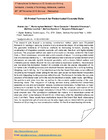Abstract
This research puts forward a pioneering construction method which uses 3D-printed formwork for casting or spraying concrete in any conceivable shape. 3D printing overcomes the geometric limitations of traditional methods for fabricating formwork, enabling the construction of integrative concrete elements with elaborate, free-form and highly detailed surfaces. The proposed method was used in a full-scale architectural context for the Smart Slab, a 78-m2 prestressed concrete slab which consists of eleven 7.4-m-long prefabricated one-of-a-kind segments (Fig. 1). The Smart Slab is a fully functional structural element which showcases an exquisite digitally designed geometry, with a deeply folded surface and millimetre-precise details. Beyond the new and radically expressive aesthetic, this extensive and tolerance-free fabrication freedom for concrete enables the precise integration of the complete suite of building services and structural features necessary for a working building. Weighing over 9,000 Kg, the 3D-printed formwork for the Smart Slab relies on two different 3D printing technologies: binder jetting for the most part, as well as fused filament deposition for locally integrating building services within the slab. The formwork facilitates the accurate provision of functional voids within the slab for electrical conduits, water ducts, light fittings, fire sprinklers and rebar form ties, as well as for the accurate spatial curving of the posttensioning ducts. The integration of building services during prefabrication streamlines assembly on site and considerably reduces construction tolerances. Furthermore, a major achievement enabled by the 3D-printed formwork was the structural optimisation of the Smart Slab and consequent weight reduction of almost 70% in comparison to a conventional solid concrete slab. The optimisation distributed the material in a hierarchical curved rib structure, which varies between 30 and 60 cm in thickness, while the interstitial surfaces are only 2 cm thick. These results have implications beyond the Smart Slab itself, showcasing how the material strength of concrete can be advantageously combined with the geometric freedom of 3D printing in a new construction method for free-form load-bearing elements. Show more
Permanent link
https://doi.org/10.3929/ethz-b-000507651Publication status
publishedPublisher
ETH Zurich, Digital Building Technologies (ITA)Event
Subject
Concrete; Formwork; 3D Printing; Digital fabricationOrganisational unit
09566 - Dillenburger, Benjamin / Dillenburger, Benjamin
02284 - NFS Digitale Fabrikation / NCCR Digital Fabrication
Funding
141853 - Digital Fabrication - Advanced Building Processes in Architecture (SNF)
Related publications and datasets
Is cited by: https://doi.org/10.3929/ethz-b-000614681
Notes
Conference lecture held on 28 November 2018.More
Show all metadata
ETH Bibliography
yes
Altmetrics



